#dutch abstract expressionism
Explore tagged Tumblr posts
Text
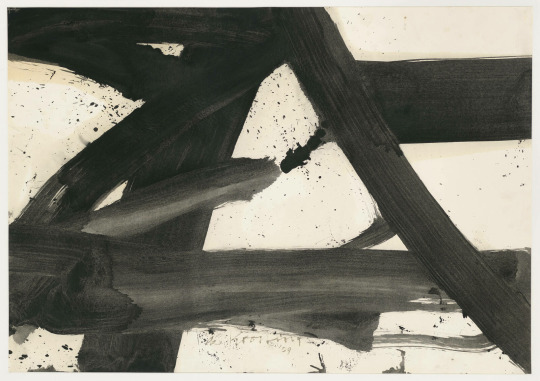
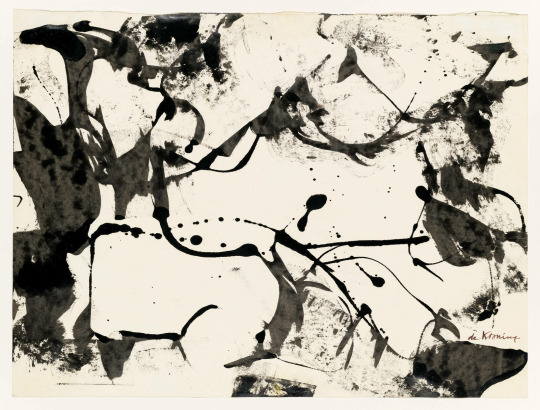
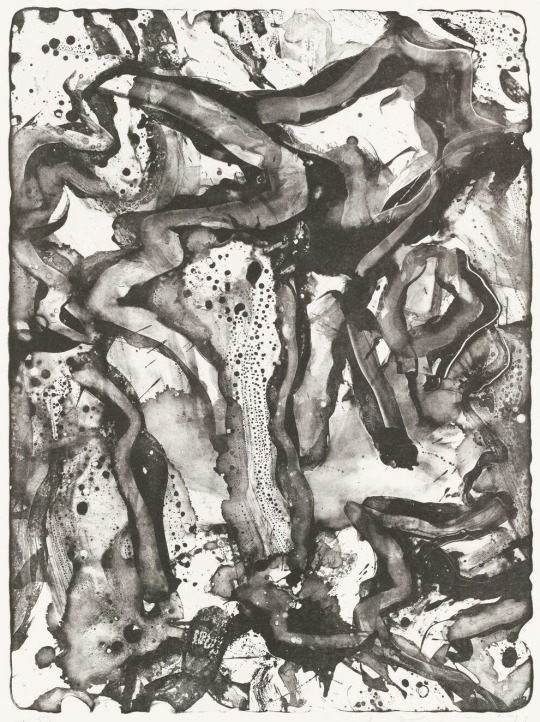
Willem de Kooning, Black and White, 1959
Willem de Kooning, Landscape, Abstract, c. 1949
Willem de Kooning, Landscape at Stanton Street, 1971
#willem de kooning#abstract expressionism#abstract expressionist#abstraction#abstract artist#abstract aesthetic#abstract art#abstract expressionist art#abstract#american art#american painting#dutch artist#dutch painter#american artist#aesthetic#beauty#modern art#art history#aesthetictumblr#tumblraesthetic#tumblrpic#tumblrpictures#tumblr art#tumblrstyle#artists on tumblr
126 notes
·
View notes
Text

Halloween Leftovers
Prompt: a painting of smoke in a dark hallway, in the style of expressive figurative abstraction, made of liquid metal, dark white and violet, organic biomorphic forms, digital art techniques, action painting, delicate ink washes:: an ice cream cone that is white, in the style of post-apocalyptic landscapes, digital expressionism, dutch marine scenes, fish-eye lens, palette knife work, romanticized country life
Prompt smashing makes for odd gens.
The image(s) above in this post were made using an autogenerated prompt and/or have not been modified/iterated extensively. As such, they do not meet the minimum expression threshold, and are in the public domain.
#unreality#midjourney v5#generative art#ai artwork#public domain art#public domain#free art#auto-generated prompt
14 notes
·
View notes
Text
Subjectively ranking the Top 10 most influential artists and the works that changed the art world: An ‘Ism’ Overview - Perspectives Comparing And contrasting art movements
Leonardo da Vinci (1452-1519): Leonardo is considered one of the most brilliant minds in history, and his art spans across various genres. His most famous works include the Mona Lisa and The Last Supper, which revolutionized painting techniques, particularly in the use of light and shadow.
Michelangelo Buonarroti (1475-1564): Michelangelo is best known for his sculptures, including the statue of David and the Sistine Chapel ceiling frescoes. He is associated with the High Renaissance period, and his works remain significant in the art world due to his technical expertise and realism.
Pablo Picasso (1881-1973): Picasso is regarded as one of the most important artists of the 20th century, co-founding the Cubist movement with Georges Braque. His most famous works include Les Demoiselles d'Avignon, Guernica, and The Old Guitarist. Picasso's works paved the way for modern art, particularly in the use of abstraction and unconventional materials.
Vincent van Gogh (1853-1890): Van Gogh is known for his post-Impressionist style, which was characterized by bold colours and emotional expression. His most famous works include Starry Night, Sunflowers, and The Potato Eaters. Van Gogh's works were a precursor to Expressionism, which emphasized the emotional and spiritual content of art.
Rembrandt van Rijn (1606-1669): Rembrandt is considered one of the greatest painters in European history, specializing in portraiture and Biblical scenes. His most famous works include The Night Watch and Self-Portrait with Two Circles. Rembrandt's use of light and shadow, as well as his ability to capture emotions, influenced the Baroque period of art.
Henri Matisse (1869-1954): Matisse was a leader of the Fauvism movement, which emphasized bright, bold colours and simplified forms. His most famous works include The Dance, Red Room, and Harmony in Red. Matisse's use of color and form paved the way for the development of Abstract Expressionism.
Johannes Vermeer (1632-1675): Vermeer was a Dutch painter who specialized in interior scenes, particularly of women. His most famous works include Girl with a Pearl Earring, The Milkmaid, and The Art of Painting. Vermeer's use of light and shadow, as well as his attention to detail, influenced the development of Realism.
Salvador Dali (1904-1989): Dali was a Spanish surrealist painter who specialized in creating bizarre, dreamlike images. His most famous works include The Persistence of Memory, The Hallucinogenic Toreador, and Soft Construction with Boiled Beans. Dali's works challenged traditional notions of art and reality, paving the way for the development of Surrealism.
Wassily Kandinsky (1866-1944): Kandinsky was a Russian artist and art theorist who is credited with creating the first purely abstract works of art. His most famous works include Composition VIII, Composition VII, and Black and Violet. Kandinsky's works paved the way for the development of Abstract Expressionism, which emphasized the spontaneous, subconscious creation of art.
Claude Monet (1840-1926): Monet was a French Impressionist painter who specialized in capturing the effects of light and atmosphere in his works. His most famous works include Water Lilies, Rouen Cathedral series, and Haystacks. Monet's use of light and colour influenced the development of Impressionism, which emphasized the fleeting nature of light and colour in art.
3 notes
·
View notes
Text
New York City Culture🗽
New York City is frequently the setting for novels, movies, and television programs and has been described as the cultural capital of the world. In describing New York, author Tom Wolfe said, "Culture just seems to be in the air, like part of the weather."
The city is the birthplace of many cultural movements, including the Harlem Renaissance in literature and visual art; abstract expressionism (known as the New York School) in painting; and hip-hop, punk, hardcore, salsa, freestyle, Tin Pan Alley, certain forms of jazz, and (along with Philadelphia) disco in music. New York City has been considered the dance capital of the world.
One of the most common traits attributed to New York City is its fast pace, which spawned the term New York minute. Journalist Walt Whitman characterized New York's streets as being traversed by "hurrying, feverish, electric crowds". New York City's residents are prominently known for their resilience historically, and more recently related to their management of the impacts of the September 11 terrorist attacks and the COVID-19 pandemic. New York was voted the world's most resilient city in 2021 and 2022 per Time Out's global poll of urban residents.
Theater🎭
The central hub of the American theater scene is Manhattan, with its divisions of Broadway, off-Broadway, and off-off-Broadway. Many movie and television stars have gotten their big break working in New York productions.
Broadway theatre is one of the premier forms of English-language theatre in the world, named after Broadway, the major thoroughfare that crosses Times Square, sometimes referred to as "The Great White Way".
Forty-one venues mostly in Midtown Manhattan's Theatre District, each with at least 500 seats, are classified as Broadway theatres. The 2018–19 Broadway theatre season set records with total attendance of 14.8 million and gross revenue of $1.83 billion Recovering from closures forced by the COVID-19 pandemic, 2022-23 revenues rebounded to $1.58 billion with total attendance of 12.3 million.
The Tony Awards recognizes excellence in live Broadway theatre and are presented at an annual ceremony in Manhattan. The awards are given for Broadway productions and performances at the 41 eligible Broadway venues. One is also given for regional theatre. Several discretionary non-competitive awards are given as well, including a Special Tony Award, the Tony Honors for Excellence in Theatre, and the Isabelle Stevenson Award.

Architecture
New York has architecturally noteworthy buildings in a wide range of styles and from distinct time periods, from the Dutch Colonial Pieter Claesen Wyckoff House in Brooklyn, the oldest section of which dates to 1656, to the modern One World Trade Center, the skyscraper at Ground Zero in Lower Manhattan and the most expensive office tower in the world by construction cost.
Manhattan's skyline, with its many skyscrapers, is universally recognized, and the city has been home to several of the tallest buildings in the world. As of 2019, New York City had 6,455 high-rise buildings, the third most in the world after Hong Kong and Seoul.
The character of New York's large residential districts is often defined by the elegant brownstone rowhouses and townhouses and shabby tenements that were built during a period of rapid expansion from 1870 to 1930. Stone and brick became the city's building materials of choice after the construction of wood-frame houses was limited in the aftermath of the Great Fire of 1835.
In contrast, New York City also has neighborhoods that are less densely populated and feature free-standing dwellings. In neighborhoods such as Riverdale (in the Bronx), Ditmas Park (in Brooklyn), and Douglaston (in Queens), large single-family homes are common in various architectural styles such as Tudor Revival and Victorian.
Arts🩰
Lincoln Center for the Performing Arts, anchoring Lincoln Square on the Upper West Side of Manhattan, is home to numerous influential arts organizations, including the Metropolitan Opera, New York City Opera, New York Philharmonic, and New York City Ballet, as well as the Vivian Beaumont Theater, the Juilliard School, Jazz at Lincoln Center, and Alice Tully Hall. The Lee Strasberg Theatre and Film Institute is in Union Square, and Tisch School of the Arts is based at New York University, while Central Park SummerStage presents free music concerts in Central Park.
New York City has more than 2,000 arts and cultural organizations and more than 500 art galleries. The city government funds the arts with a larger annual budget than the National Endowment for the Arts. The city is also home to hundreds of cultural institutions and historic sites. Museum Mile is the name for a section of Fifth Avenue running from 82nd to 105th streets on the Upper East Side of Manhattan, in the upper portion of Carnegie Hill.
Nine museums occupy the length of this section of Fifth Avenue, making it one of the densest displays of culture in the world. Its art museums include the Guggenheim, Metropolitan Museum of Art, Neue Galerie New York, and The Africa Center. In addition to other programming, the museums collaborate for the annual Museum Mile Festival, held each year in June, to promote the museums and increase visitation. Many of the world's most lucrative art auctions are held in New York City.
The Metropolitan Museum of Art is the largest art museum in the Americas. In 2022, it welcomed 3.2 million visitors, ranking it the third most visited U.S. museum, and eighth on the list of most-visited art museums in the world. Its permanent collection contains more than two million works, divided among 17 curatorial departments, and includes works of art from classical antiquity and ancient Egypt; paintings and sculptures from nearly all the European masters; and an extensive collection of American and modern art. The Met maintains extensive holdings of African, Asian, Oceanian, Byzantine, and Islamic art.
Fashion🛍️
New York has frequently been ranked the top fashion capital of the world on the annual list compiled by the Global Language Monitor. New York Fashion Week (NYFW) is a high-profile semiannual event featuring models displaying the latest wardrobes created by prominent fashion designers worldwide in advance of these fashions proceeding to the retail marketplace.
NYFW sets the tone for the global fashion industry. New York's fashion district encompasses roughly 30 city blocks in Midtown Manhattan, clustered around a stretch of Seventh Avenue nicknamed Fashion Avenue. New York's fashion calendar also includes Couture Fashion Week to showcase haute couture styles. The Met Gala is often described as "Fashion's biggest night".
Parades
New York City is well known for its street parades, the majority held in Manhattan. The primary orientation of the annual street parades is typically from north to south, marching along major avenues. The annual Macy's Thanksgiving Day Parade is the world's largest parade, beginning alongside Central Park and proceeding southward to the flagship Macy's Herald Square store; the parade is viewed on telecasts worldwide and draws millions of spectators in person. Other notable parades including the annual New York City St. Patrick's Day Parade in March, the NYC LGBT Pride March in June, the LGBT-inspired Greenwich Village Halloween Parade in October, and numerous parades commemorating the independence days of many nations. Ticker-tape parades celebrating championships won by sports teams as well as other accomplishments march northward along the Canyon of Heroes on Broadway from Bowling Green to City Hall Park in Lower Manhattan.
5 notes
·
View notes
Text

What is Abstract Art?
Abstract art is art that does not represent an accurate depiction of visual reality, communicating instead through lines, shapes, colors, forms and gestural marks. Abstract artists use a variety of techniques to create their work, mixing traditional means with more experimental ideas.
The history of abstraction can be traced back to the early 20th century, when artists began to experiment with new ways of representing the world around them. Some of the earliest examples of abstract art can be found in the work of Wassily Kandinsky, who began to create non-representational paintings in the early 1900s. Other early pioneers of abstraction include Piet Mondrian, Kazimir Malevich, and Jackson Pollock.
Abstract art has been a controversial movement throughout its history, with some critics arguing that it is not truly art because it does not represent the real world. However, abstract art has also been praised for its ability to express emotions and ideas in a unique and powerful way.
Today, abstract art is a thriving and diverse movement, with artists working in a wide range of styles. Abstract art can be found in paintings, sculptures, prints, photographs, and even video installations. It is a form of art that continues to challenge and inspire viewers around the world.
Here are some of the most famous abstract artists:
* Wassily Kandinsky (1866-1944): A Russian painter and art theorist, Kandinsky is considered to be one of the pioneers of abstract art. His paintings are often characterized by their use of bright colors and bold shapes.
* Piet Mondrian (1872-1944): A Dutch painter, Mondrian is best known for his geometric abstract paintings. His work is often associated with the De Stijl movement, which emphasized simplicity and abstraction.
* Kazimir Malevich (1878-1935): A Russian painter, Malevich is best known for his black square paintings. His work is often associated with Suprematism, a movement that emphasized the primacy of pure form in art.
* Jackson Pollock (1912-1956): An American painter, Pollock is best known for his drip paintings. His work is often associated with Abstract Expressionism, a movement that emphasized the artist's individual expression.
* Mark Rothko (1903-1970): An American painter, Rothko is best known for his large-scale abstract paintings. His work is often associated with Color Field Painting, a movement that emphasized the use of color and form in art.
Abstract art is a complex and fascinating subject, and there is much more to it than meets the eye. If you are interested in learning more about abstract art, I encourage you to do some research and explore the work of some of the artists mentioned above.
*Sources - Learn more
acyclicnewsupdates.s3.amazonaws.com/what-is-abstract-sculpture.html
www.ohanloncenter.org/event/abstract-energy-color-w-peller-marion-2022-06-21/
www.riseart.com/guide/2366/guide-to-abstract-art
About the Author
Alec Allshouse is an artist, musician, and the founder of Allshouse Designs, a website design business that creates websites for small businesses since 2012. Since 1998, Alec has managed over 200 websites.
10 notes
·
View notes
Photo

Interchanged, currently at the Norton Museum of Art, is an abstract expressionist oil painting on canvas by Dutch-American painter Willem de Kooning. Like Jackson Pollock, de Kooning was one of the early artists of the abstract expressionism movement, the first American modern art movement. The painting measures 200.7 by 175.3 centimeters and was completed in 1955. It marked the transition of the subjects of de Kooning's paintings from women to abstract urban landscapes. It reflects a transition in de Kooning's painting technique due the influence of artist Franz Kline, who inspired de Kooning to paint with quickly made gestural marks as opposed to violent brush strokes. The painting features a fleshy pink mass at its center, representing a seated woman. Originally sold by the artist in 1955 for $4,000, it was sold by the David Geffen Foundation to Kenneth C. Griffin for $300 million in September 2015, then ranking it first on the list of most expensive paintings. It has been on loan at the Art Institute of Chicago. It is now ranked second on the list of most expensive paintings, only surpassed by Leonardo da Vinci’s Salvator Mundi, which sold for $450.3 million in November 2017. In September 2015, Geffen sold Interchange for $300 million to hedge fund manager and billionaire Kenneth C. Griffin. Griffin paid $500 million for two artworks, including $200 million for Jackson Pollock's Number 17A. Photo by Jay Kravetz https://www.instagram.com/p/Cp2gsGRMtch/?igshid=NGJjMDIxMWI=
5 notes
·
View notes
Text
Abstract Art

Vincent Van Gogh's "Starry Night" is a fascinating work. Painted in June 1889, this canvas depicts a night view from Van Gogh's room at the Saint-Paul-de-Mausole asylum in Saint-Rémy-de-Provence. The painting is dominated by a swirling sky filled with scrolls and luminous stars. The Moon, visible in the upper right, and Venus, to the right of the cypress tree, are surrounded by halos of light. The village at the bottom of the painting, with its Dutch-style church tower, is a stylized representation of Saint-Rémy-de-Provence.
For me, The Starry Night evokes a sense of calm and contemplation, but also a certain inner turmoil, reflected by the swirls and swirls of the sky. The stars and moon, surrounded by luminous halos, seem almost alive, creating a mystical and dreamlike atmosphere.
What attracts me the most in this painting is the unique combination of realism and expressionism. Van Gogh managed to capture not only the beauty of the night sky, but also his own emotions and perceptions. The contrast between the calm of the village below and the dynamic movement of the sky above can symbolize the duality between the tranquility outside and the tumult inside. The colors, the shapes, and the personal story of Van Gogh behind this work. The painting is famous for its celestial swirls and luminous stars, creating an atmosphere that is both peaceful and tormented.
Analysis, Van Gogh uses dynamic, thick brushstrokes to create an effect of movement in the sky. The bright, contrasting colors add to the emotional intensity of the work. The dark cypress in the foreground can symbolize death or eternity, while the starry sky represents infinity and the beauty of nature. Impact "The Starry Night" is often considered one of Van Gogh's greatest works and has had a lasting influence on modern art. It is currently on display at the Museum of Modern Art (MoMA) in New York.
In summary, "The Starry Night" is a work rich in emotions, mixing personal torment, hope, isolation and spirituality. It reflects both Van Gogh's state of mind and his unique vision of the world.
0 notes
Text
Research/Readings/Artists
Lady Aiko
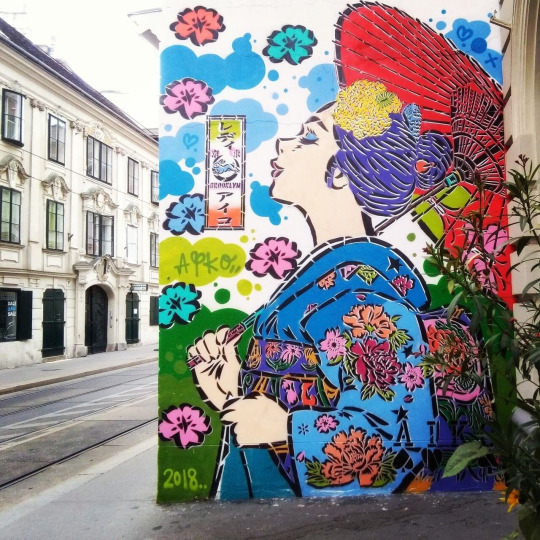
i like the artists style and use of colour
Japanese street artist
i like that she incorporates her culture in this new modern contemporary style
it kind of makes it look like its its own being like a character being created that embodies the very traditions and cultures of the artist
her works also explore the whimsical and fantasy
techniques used: Stencil/handcut stencil, influence of traditional Japanese Art
Hugo Kaagman
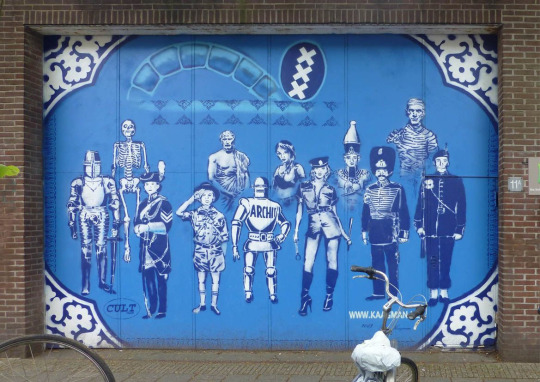
Dutch Stencil Artist
i like the outcome of using a stencil
i like the finished products of him using these stencils but also adding these detailed design similar to these mosaic plates
i also like that all the figures he has used don't stick to a certain pattern or style they all vary in different representations of characters to characters or rather imaginary characters
he uses old Dutch blue Delftware paired with contemporary symbols as a means of communicating his perspective on current society
techniques used: Pattern/repetition, stencil, Mixed media
Eric Inkala
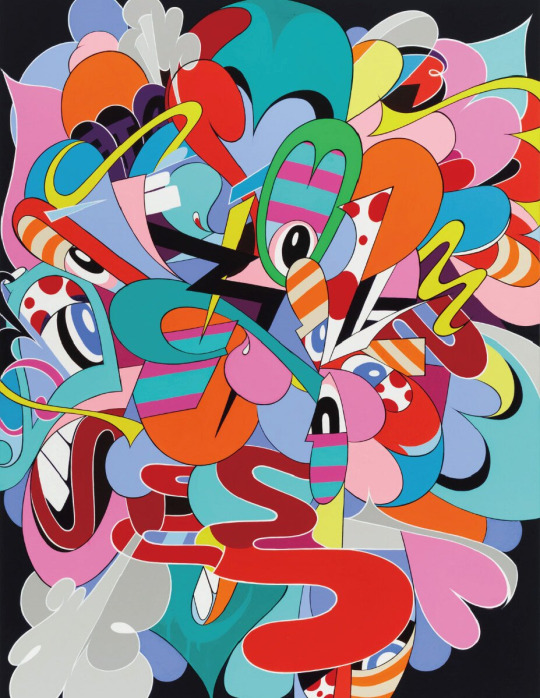
i like his use of bold and vibrant colours, playful shapes
i don't know its like this blend between abstract, graffiti and street art
his art is a personal expression of emotions, experiences and thoughts
i like how the shapes he created directs your eyes, like you can see the movement within this whimsical piece
i like it, although there is an abundance of forms, colours and so on it still works
it does feel crammed and claustrophobic but for me its like the forms and colours mask this
i have done something similar on A5 with oil pastel but not this scale
i have noticed so far that the artists that interest me have alot of detail however im not sure if i am wanting to achieve this. maybe i am but its subconscious or something?
ALSO:
i actually have an idea for these two artists. well not for them rather for me but the idea incorporates aspects from these two artists. more specifically the stencil and aspects of my own culture.

Galenson, D. W. (2018, March 1). Pricing revolution: From abstract expressionism to pop art. Research in Economics.
"The innovations of the Abstract Expressionists were based on extended experimentation, as they searched for novel visual images; Pop artists rejected this open-ended search for personal forms, and instead treated painting as the impersonal transcription of preconceived ideas."
"Accumulation of experience was critical for the Abstract Expressionists, who produced their most valuable art late in their lives, whereas lack of experience allowed the next generation the freedom to imagine radically new approaches, and they produced their most valuable art early in their careers."
i liked this article as it reminded me of my own practice, at times i find myself shutting of my mind (in terms of planning or thinking about creating) and just creating
although i do find myself doing both, i do at times plan or take an image and recreate it to form something new but at times i only use this as a starting point in my process
i start with a pre conceived idea, only to then begin this phase in which i limit my thoughts and just create
i mean reading this makes me question if i can merge aspects of the two to create this new form of creative expression
what if i create by being oblivious to elements and principles of design? is it possible? am i capable of doing it ?
0 notes
Text
Willem de Kooning was a Dutch-American painter and one of the representatives of Abstract Expressionism. The human body is the main subject of his paintings, adding landscapes and textual symbols to develop his abstract world. He incorporated Surrealist and Expressionist styles into his vast and powerful painting movements, integrating radical artistic ideas into his own artistic world. Even the extreme paintings have artistic beauty and I feel a connection between his work and his soul. In different stages of his life and living environment, his works show different styles and characteristics. From the anxiety at the bottom of life to the inner peace in later years, from the madness of big City to the tranquility of a rural lake, they are all vividly expressed in his works.
Alice Neel is an American painter born in Pennsylvania, USA in 1900. She is famous for her realistic figure paintings, especially portraits. Alice Neal lived during the heyday of Abstract Expressionism in New York. But her work had nothing to do with the artistic trends of the time. Her works are full of human fireworks and rich earthy flavor. Rather than just expressing her own inner spiritual world, she prefers to depict the souls of others. Her works not only show the appearance of models, but also focus on depicting different souls shaped by life.
0 notes
Text


Vincent van Gogh, Ears of Wheat, 1890, Auvers-sur-oise, France
Jackson Pollock. Full Fathom Five, 1947
#vincent van gogh#jackson pollock#post impressionism#post impressionist art#dutch artist#dutch painter#american artist#american painter#american art#dutch painting#post impressionist#abstract expressionism#abstract expressionist art#abstract art#art on tumblr#aesthetic#beauty#modern art#art history#aesthetictumblr#tumblraesthetic#tumblrpic#tumblrpictures#tumblr art#art aesthetic
43 notes
·
View notes
Text
Joop Sanders, early member of Abstract Expressionist movement, has died, aged 101
Joop Sanders, the Dutch American painter who played a key role in Abstract Expressionism, has died. He was 101 years old. According to Artforum, the artist died on 6 July, and his death was confirmed by his son-in-law, the photographer Timothy Greenfield-Sanders. Sanders came to the United States as a teenager fleeing the Nazi regime, but a brief return to Europe in the 1950s—just as the AbEx…

View On WordPress
0 notes
Text
Asynchronous Assignment
Willem De Kooning
A Dutch-American expressionist artist and draughtsman or Draftsman, who is well known for his works of abstract expressionism with very bizarre and surreal designs, works like “Woman I” which took him 3 years to make, “Asheville”, “Gotham News”, and etc. Willem idea of expression that he drew was meant to be funny hence the bizarre designs on his Women artwork. The many scribbles may seem random but that not entirely true since all the scribbles makes shape and abstracts which brings back his talents as a draftsman.
Alice Neel
Alice Neel is a visual artist who make artworks of relative and strangers Nude or not throughout the Great Depression giving out an expressional feeling in that time. Her paintings have an expressionistic use of line and color, psychological acumen, and emotional intensity. All of her work other than a self-portrait is “The Family”, “The Sea”, “Well Baby Clinic” and etc.
Lucian Freud
Lucian Freud is a British painter and draughtsman, specializing in figurative art, and is known as one of the foremost 20th-century English portraitists. He was influence by surrealism but later fall towards realism around the 1950s. He done surreal to realistic portrait like “Reflection”, “Portrait of Francis Bacon”, “Man with a feather”, “Reflection of the two kid”, and etc.
What impress me more about their works?
What impress me more is how they manage to release their work to public with confidence, though I don’t know if they were confidant or not. though William De Kooning was the one I see more on how he paints and how impress he use from the brush to use speed to make the design instead of taking his time.
My favorite Artist is Alice Neel
My reason why I pick Alice Neel was simply because of how her artwork or portrait give off a humanism world, seeing the people in the painting especially during the Great Depression does give us an idea on how people in art we’re in the present/past. I feel like that what many artist are drawing the present and interpret the now for the future.
#Miami Dade College#north campus#willem de kooning#alice neel#lucian freud#asynchronous#assiginment#art1330c
0 notes
Photo
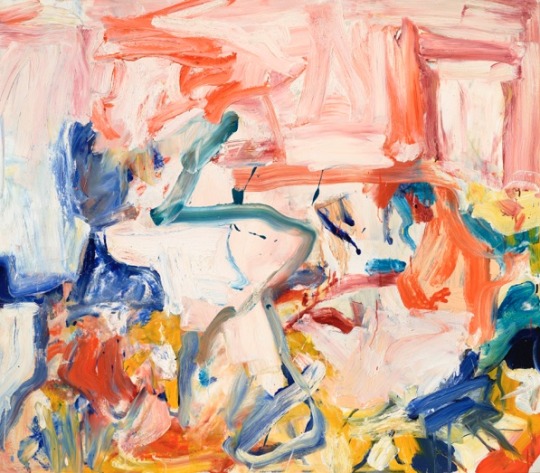
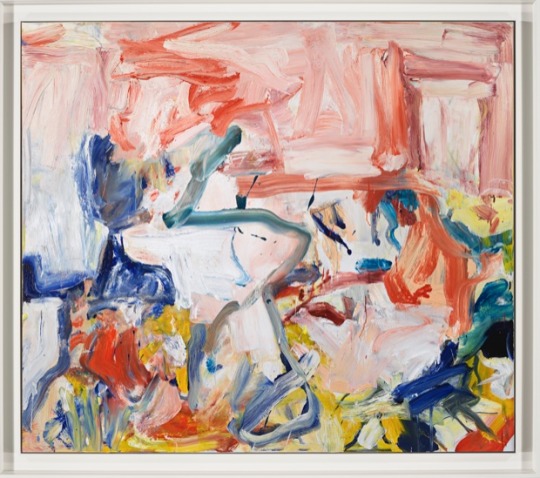

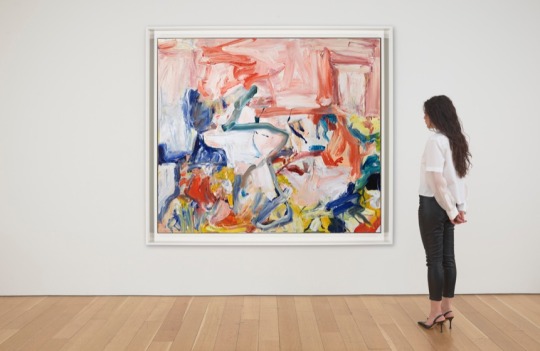
WILLEM DE KOONING Untitled XXI
Signed 'de Kooning' (on the reverse). Oil on canvas. 70 x 80 in. (177.8 x 203.2 cm.). Painted in 1977.
#Willem de Kooning Untitled XXI 1977#Dutch-American abstract expressionist artist#painter#painting#art#artist#art work#art news#abstract expressionism#action painting#pretty#beauty#beautiful#color#colorful#vivid#oil on canvas
7 notes
·
View notes
Text
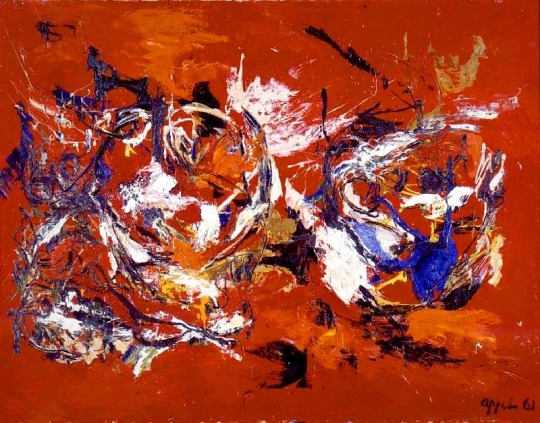
Head Burst on Red by Karel Appel (Dutch, 1921–2006), 1961, Oil on canvas, 229 x 299 cm. The Israel Museum.

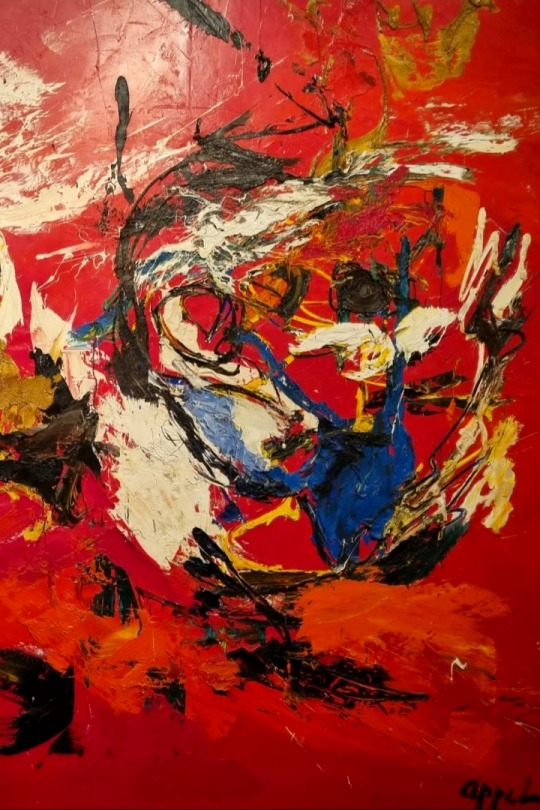
#art#karel appel#dutch artist#20th century#60's#oil on canvas#large painting#modern art#avant garde#abstract expressionism#CoBrA art movement#art history
23 notes
·
View notes
Photo

Jacqueline de Jong - Big foot small head (for Thomas) (1985)
From the series Upstairs-Downstairs, Oil on canvas.
#Jacqueline de Jong#Imaginary Disobedience#cobra#dutch painting#dutch art#abstract expressionism#surrealism#situationism#painting#abstract
12 notes
·
View notes
Photo

Interchanged, currently at the Norton Museum of Art, is an abstract expressionist oil painting on canvas by Dutch-American painter Willem de Kooning. Like Jackson Pollock, de Kooning was one of the early artists of the abstract expressionism movement, the first American modern art movement. The painting measures 200.7 by 175.3 centimeters and was completed in 1955. It marked the transition of the subjects of de Kooning's paintings from women to abstract urban landscapes. It reflects a transition in de Kooning's painting technique due the influence of artist Franz Kline, who inspired de Kooning to paint with quickly made gestural marks as opposed to violent brush strokes. The painting features a fleshy pink mass at its center, representing a seated woman. Originally sold by the artist in 1955 for $4,000, it was sold by the David Geffen Foundation to Kenneth C. Griffin for $300 million in September 2015, then ranking it first on the list of most expensive paintings. It has been on loan at the Art Institute of Chicago. It is now ranked second on the list of most expensive paintings, only surpassed by Leonardo da Vinci’s Salvator Mundi, which sold for $450.3 million in November 2017. In September 2015, Geffen sold Interchange for $300 million to hedge fund manager and billionaire Kenneth C. Griffin. Griffin paid $500 million for two artworks, including $200 million for Jackson Pollock's Number 17A. Photo by Jay Kravetz https://www.instagram.com/p/Cp3BalrA8Cu/?igshid=NGJjMDIxMWI=
0 notes